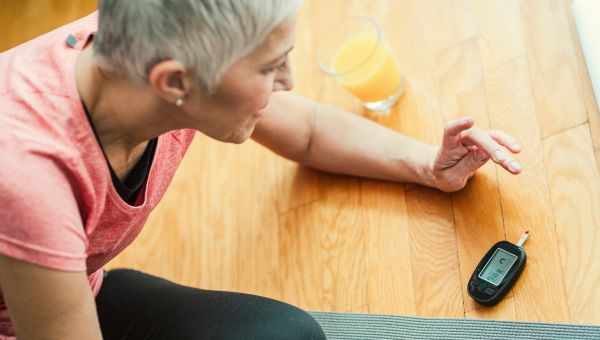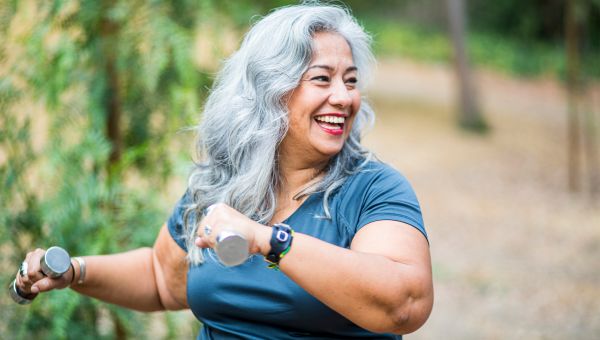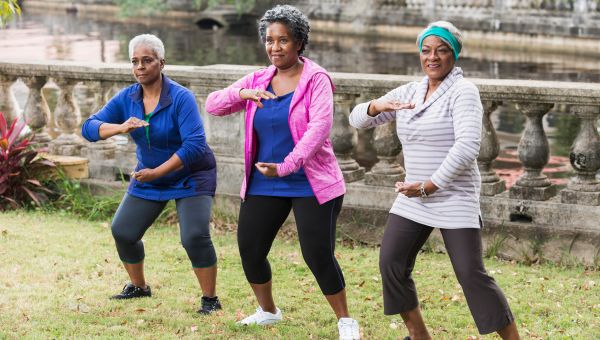How to exercise with type 2 diabetes
Learn how getting physically active helps manage blood sugar levels and discover the safest ways to get fit.
Updated on March 15, 2024

Along with following a healthy diet, getting regular exercise is an important way to help manage your blood sugar levels if you have diabetes. Exercise can also help you manage your weight and reduce the risk of heart disease. But what kind of exercise, and how much, is necessary to reap those benefits?
The American Diabetes Association (ADA) recommends getting 150… Show More
Along with following a healthy diet, getting regular exercise is an important way to help manage your blood sugar levels if you have diabetes. Exercise can also help you manage your weight and reduce the risk of heart disease. But what kind of exercise, and how much, is necessary to reap those benefits?
The American Diabetes Association (ADA) recommends getting 150 minutes per week of aerobic exercise (such as walking), spread out over most days of the week. Strength training is important, too. That might involve two to three sessions per week of exercises using weights, resistance bands, or your own body weight (like doing push-ups or squats). For older adults with diabetes, the ADA also recommends including exercises that improve balance and flexibility (such as yoga) two to three times per week.
Whether you’re just starting out or looking to build on your existing workout, here’s what you need to know.
Show Less
Before you get started
Exercise helps lower blood sugar levels because it removes sugar from your blood and uses it for energy. Your body also stores sugar in your muscles and liver and the sugar from these sources fuels your workouts.
But sometimes exercising can cause your blood glucose to drop too low, putting you at… Show More
Exercise helps lower blood sugar levels because it removes sugar from your blood and uses it for energy. Your body also stores sugar in your muscles and liver and the sugar from these sources fuels your workouts.
But sometimes exercising can cause your blood glucose to drop too low, putting you at risk for what’s known as hypoglycemia (low blood sugar levels, with symptoms like tiredness, dizziness, confusion, feeling sweaty, or irritability). That’s one reason why it’s important to get approval from a healthcare provider (HCP) before you begin an exercise program or make any big changes to your workout. You should also consult an HCP to make sure that your exercise regime is appropriate and safe for your level of fitness.
Show Less
Track your blood sugar levels
To exercise safely, you’ll need to see how your blood sugar level responds to different types of physical activity. Check your blood sugar before, after, and possibly during exercise to be sure it’s at a healthy level. If it isn’t, eat a snack. Generally, it’s recommended that your blood sugar… Show More
To exercise safely, you’ll need to see how your blood sugar level responds to different types of physical activity. Check your blood sugar before, after, and possibly during exercise to be sure it’s at a healthy level. If it isn’t, eat a snack. Generally, it’s recommended that your blood sugar should be between 100 mg/dl and 250 mg/dl before starting a workout. Check with your HCP for your recommended range and discuss any necessary adjustments to your medication.
Several types of diabetes medications have the potential to cause low blood sugar during or after exercise, while other medications carry little or no risk of hypoglycemia. According to the ADA and the American College of Sports Medicine, adjusting medication for physical activity is generally necessary only for people with diabetes who use insulin or oral medications that stimulate insulin secretion. These medicines include sulfonylureas (including glyburide, glipizide and glimepiride) or meglitinides (including nateglinide and repaglinide).
Don’t forget to continue monitoring your blood sugar levels after your workout ends to be on the lookout for hypoglycemia that may develop after exercise, which can occur up to 24 hours after exercise when your body’s carbohydrate levels become depleted. High-intensity exercise, in particular, may lower blood sugar levels but can also increase them, particularly for interval-training and weight lifting.
Show Less
Look out for blood sugar dips
While you’re exercising, you should be prepared in case your blood sugar level drops too low. Remember to take along carbohydrates that can bring your blood sugar levels up. The ADA’s preferred treatment for someone with blood sugar levels below 70 mg/dl who’s still conscious is 15 to 20 grams of… Show More
While you’re exercising, you should be prepared in case your blood sugar level drops too low. Remember to take along carbohydrates that can bring your blood sugar levels up. The ADA’s preferred treatment for someone with blood sugar levels below 70 mg/dl who’s still conscious is 15 to 20 grams of fast-acting glucose (sugar). (That's the amount found in four to five glucose tablets or one glucose gel tube.) But any form of carbohydrate that contains glucose is typically okay. That might be 4 to 6 ounces of regular-sugar juice or soda or 1 tablespoon of sugar, honey or fruit jelly, for instance.
Show Less
Stay hydrated
It’s also important to stay properly hydrated when you exercise. Check with your HCP about what amounts of water or other drinks you should take in before, during, and after your workout so that you can be sure to replace the essential fluids you lose while you sweat.

Prepare for possible emergencies
Carry a cell phone when you exercise, especially if you like to work out alone, and wear a medical alert bracelet. If you’re unable to speak, a medical ID tag can be a lifesaver, alerting strangers and first responders to your name, diabetes status, contact information, and emergency instructions.

Start (and finish) with a stretch
Once you’ve done your preparation for working out, it’s time to get moving. Doing stretches increases flexibility (which helps improve range of motion), prevents stiffness, and enhances coordination, reducing your chance of injury. A study published in the Journal of Physical Therapy Science… Show More
Once you’ve done your preparation for working out, it’s time to get moving. Doing stretches increases flexibility (which helps improve range of motion), prevents stiffness, and enhances coordination, reducing your chance of injury. A study published in the Journal of Physical Therapy Science suggests that stretching also helps people with type 2 diabetes manage their blood sugar levels.
Warm up and cool down with easy stretches for about five minutes before and after each workout. Breathe slowly and deeply while holding each move and don’t bounce up and down. You should only feel mild tension when you stretch. If you feel pain, pull back or stop.
Show Less
Get your heart rate up
Aerobic exercise is a key component of any routine, as it improves your overall fitness. The best way to stick with a program? Pick an activity you enjoy that complements your lifestyle. Walking, for example, is a low-cost, easy-on-the joints exercise that may fit into your schedule. For maximum… Show More
Aerobic exercise is a key component of any routine, as it improves your overall fitness. The best way to stick with a program? Pick an activity you enjoy that complements your lifestyle. Walking, for example, is a low-cost, easy-on-the joints exercise that may fit into your schedule. For maximum benefit, walk quickly and keep up a steady pace.
Are you just starting your exercise routine? Work up to 150 minutes of exercise per week by breaking up your walks into shorter bouts of 10 minutes until you reach the ADA’s ideal goal of 30 minutes a day, fives times per week. Some smartphone apps can help you track your daily steps. When possible, take your walk outdoors. Studies show it can improve your mood and reduce stress.
Swimming is another great option for a joint-friendly, calorie-burning workout if you have access to a swimming pool. And since water provides resistance, swimming has the added benefit of building muscle tone. If you’re new to swimming, shoot for 10 minutes per workout, three times per week. Then gradually increase your time to about 30 minutes. Be sure to let the lifeguard know about your condition before getting into the water.
Show Less
Make time for strength training
Building muscle mass is important for everyone. Strong muscles boost metabolism, strengthen bones, help with weight loss, and improve heart health, among other benefits. If you have type 2 diabetes, it also makes it easier to manage your blood sugar levels when combined with aerobic activity like… Show More
Building muscle mass is important for everyone. Strong muscles boost metabolism, strengthen bones, help with weight loss, and improve heart health, among other benefits. If you have type 2 diabetes, it also makes it easier to manage your blood sugar levels when combined with aerobic activity like walking or swimming.
The ADA recommends two to three sessions of strength training (also known as resistance training) per week on nonconsecutive days. You can lift weights, use resistance bands, or do exercises using your own body weight, like push-ups or squats. Include both aerobic and strength training in your weekly routine to earn greater rewards.
Show Less
Prioritize flexibility and balance
The ADA recommends that older adults with diabetes do exercises that improve flexibility and balance two to three times per week. Why is that important? While stretching improves joint flexibility and range of motion, activities like yoga can help prevent falls by improving your balance.

Keep moving throughout the day
In addition to getting regular exercise, the ADA recommends that all adults—especially people with type 2 diabetes—try to avoid sitting for too long at a time. That means standing up to do a few minutes of light physical activity, like walking or stretching, every 30 minutes. Doing this may… Show More
In addition to getting regular exercise, the ADA recommends that all adults—especially people with type 2 diabetes—try to avoid sitting for too long at a time. That means standing up to do a few minutes of light physical activity, like walking or stretching, every 30 minutes. Doing this may help prevent type 2 diabetes if you’re at risk. And if you have type 2, it may help you better manage your blood sugar levels. To get into the habit, set regular reminders on your phone.
Show LessMore On


video

article

slideshow


video


video
